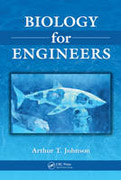
An introductory text on biology from an engineering perspective, this resource elaborates on concepts and technology with an emphasis on the utilization ofliving things. Rather than treating biology as a science requiring memorization of connections and classifications, the book explores its relevance as an application area for engineering analysis and design. The author takes a broad approach, encompassing everything from genetics and cellular structure to grand ecological systems. Ancillary materials are available with qualifying courseadoption. INDICE: I. INTRODUCTION Science and Engineering Scientific Method Mathematical Modeling Biological Engineering Expectations for Biological Engineers About Predictions About This Book Questions II. PRINCIPLES FROM THE SCIENCES Principles of Physics Effort and Flow Variables Balances States of Matter Equivalence of Work and Energy Free Energy Disorder and Entropy Heat Transfer Movement of Materials Fluid Mechanics Solid Mechanics Electricity Temperature EffectsQuestions Principles of Chemistry Periodic Nature of Elements Chemical Bonding Chemical Equilibrium Acids and Bases Reaction Rates Carbon Chemistry Physical Chemistry in Water Protein Folding Shape Effects and Enzymes Energy-Rich Compounds Temperature and Pressure Effects Free Energy Questions Principles of Mathematics and Engineering Sciences Equality Randomness and Probability Calculus Control Systems Optimization Information Analog and Digital Signal Processing Questions Principles of Biology Form and Function Modularity and IncrementalChange Genetic Basis Competition and Selection Biological Hierarchies Is Biology Complex or Simple? Questions III. RESPONSES OF LIVING SYSTEMS Biological Responses in Context BU Need Water BU Need the Right Amount of Oxygen BU Need Food and Nutrients BU Become Ill in the Presence of Wastes BU Need Heat Sourcesand Sinks BU Adapt to Their Environments BU Modify Their Environments Adaptations Require Extra Energy and Resources BU, If Possible, Move to Friendlier Environments BU Evolve under Environmental Pressures Crowding of BU Produces Stress BU Are Affected by Chemical Stresses BU Respond to Mechanical Stresses Optimization Is Used to Save Energy and Nutrient Resources BU Alter Themselves toProtect against Harsh Environments BU Cooperate with Other BU BU Compete withOther BU BU Reproduce BU Coordinate Activities through Communication BU Maintain Stability with Exquisite Control BU Go Through Natural Cycles BU Need Emotional Satisfaction and Intellectual Stimulation BU Die Questions IV. SCALING FACTORS Allometric Relationships from Evolutionary Pressure Allometric Relationships from Evolutionary Pressure Dimensional Analysis Golden Ratio Fractal Scaling within an Organism Self-Similarity for Tissues and Organs Plant Growth Self-Similarity in Populations Questions V. UTILIZING LIVING SYSTEMS Biological Engineering Solutions Systems Approach Relationships between Engineering and Biology The Completed Design Denouement Questions APPENDICES REFERENCES INDEX.
- ISBN: 978-1-4200-7763-6
- Editorial: CRC
- Encuadernacion: Cartoné
- Páginas: 757
- Fecha Publicación: 20/09/2010
- Nº Volúmenes: 1
- Idioma: Inglés
